Discover 11 hidden attractions, cool sights, and unusual things to do in Mecca (Saudi Arabia). Don't miss out on these must-see attractions: Black Stone, Hira, and Great Mosque of Mecca. Also, be sure to include Mount Arafat in your itinerary.
Below, you can find the list of the most amazing places you should visit in Mecca (Makkah).
Table of Contents
Black Stone
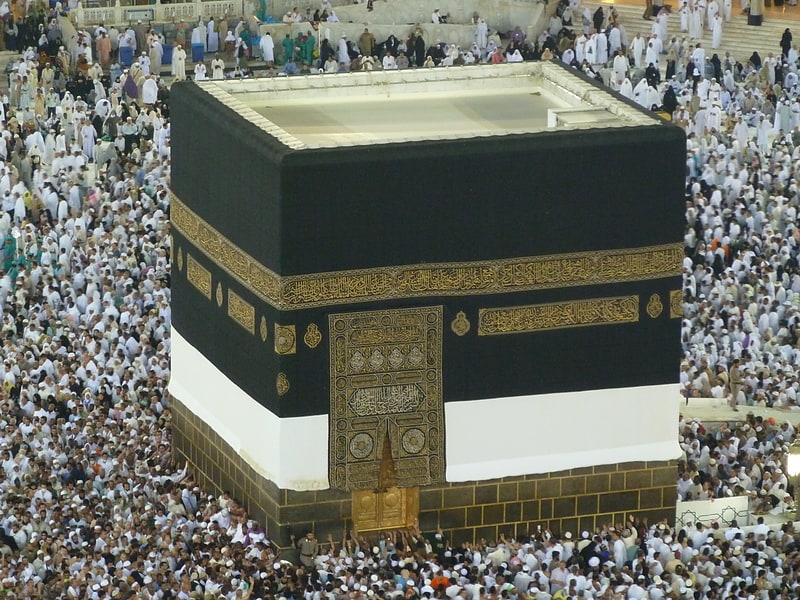
Also known as: الحجر الأسود
The Black Stone is a rock set into the eastern corner of the Kaaba, the ancient building in the center of the Grand Mosque in Mecca, Saudi Arabia. It is revered by Muslims as an Islamic relic which, according to Muslim tradition, dates back to the time of Adam and Eve.
The stone was venerated at the Kaaba in pre-Islamic pagan times. According to Islamic tradition, it was set intact into the Kaaba's wall by the Islamic prophet Muhammad in 605 CE, five years before his first revelation. Since then it has been broken into fragments and is now cemented into a silver frame in the side of the Kaaba. Its physical appearance is that of a fragmented dark rock, polished smooth by the hands of pilgrims. Islamic tradition holds that it fell from heaven as a guide for Adam and Eve to build an altar. It has often been described as a meteorite.
Muslim pilgrims circle the Kaaba as a part of the tawaf ritual during the hajj and many try to stop to kiss the Black Stone, emulating the kiss that Islamic tradition records that it received from Muhammad. Muslims do not worship the Black Stone.[1]
Address: Al Masjid Al Haram, Mecca
Hira
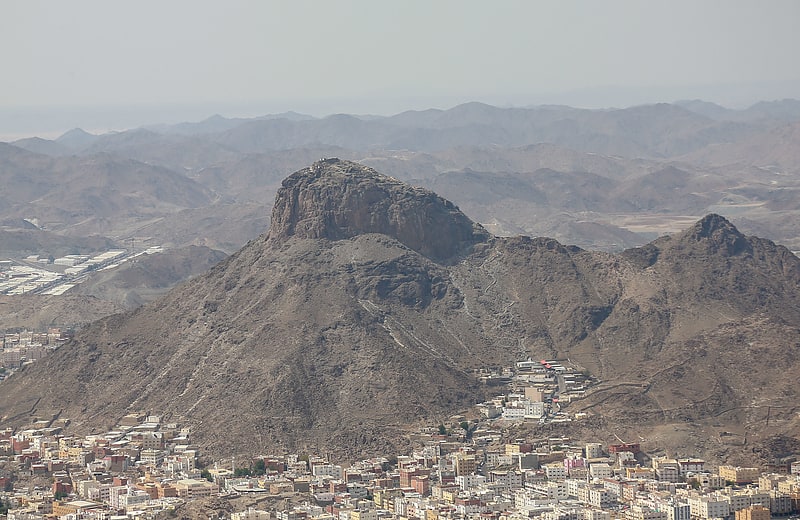
Mountain in Saudi Arabia. Jabal an-Nour is a mountain near Mecca in the Hejaz region of Saudi Arabia. The mountain houses the grotto or cave of Hira', which holds tremendous significance for Muslims throughout the world, as the Islamic prophet Muhammad is said to have spent time in this cave meditating, and it is widely believed that it was here that he received his first revelation, which consisted of the first five ayats of Surah Al-Alaq from the angel Jibra'il. It is one of the most popular tourist attractions in Makkah. The mountain itself is barely 640 m tall; nonetheless one to two hours are needed to make the strenuous hike to the cave. There are 1750 steps to the top which, even for a fit individual, can take anywhere between half an hour and one-and-a-half hours.[2]
Address: Ghar Hira, Jabl-e-noor, 24238 Makkah
Great Mosque of Mecca
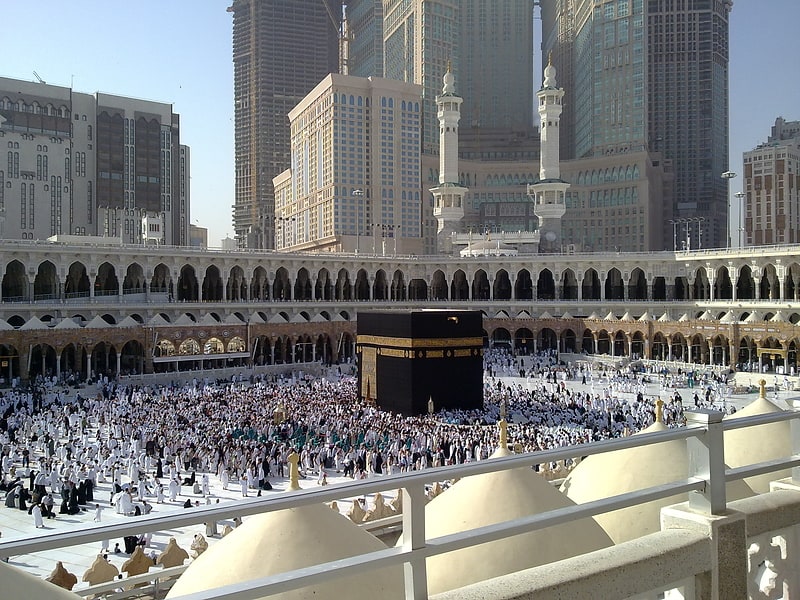
Also known as: المسجد الحرام
Great Mosque of Mecca. Masjid al-Haram, also known as the Great Mosque of Mecca, is a mosque that surrounds the Kaaba in Mecca, in the Mecca Province of Saudi Arabia. It is a site of pilgrimage in the Hajj, which every Muslim must do at least once in their lives if able, and is also the main phase for the ʿUmrah, the lesser pilgrimage that can be undertaken any time of the year. The rites of both pilgrimages include circumambulating the Kaaba within the mosque. The Great Mosque includes other important significant sites, including the Black Stone, the Zamzam Well, Maqam Ibrahim, and the hills of Safa and Marwa.
As of August 2020, the Great Mosque is the largest mosque and the eighth largest building in the world. It has undergone major renovations and expansions through the years. It has passed through the control of various caliphs, sultans and kings, and is now under the control of the King of Saudi Arabia who is titled the Custodian of the Two Holy Mosques.[3]
Mount Arafat
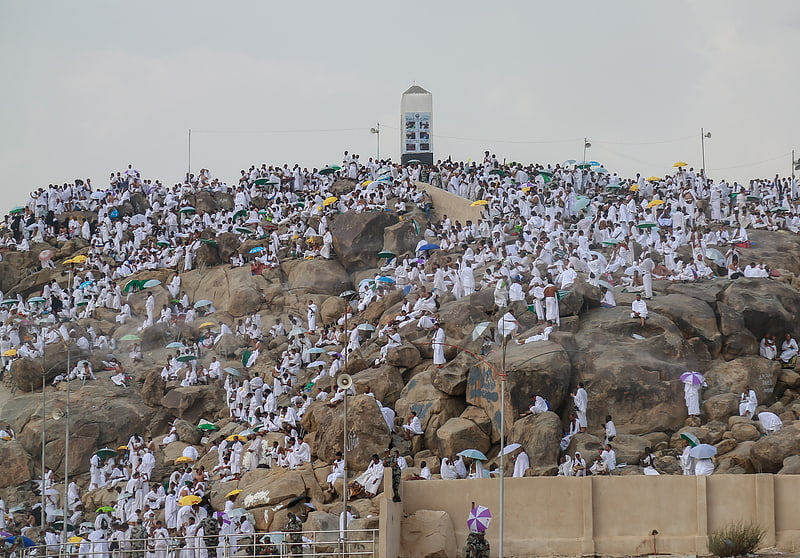
Also known as: جبل عرفة
Granite hill and Muslim pilgrimage site. Mount Arafat, and by its other Arabic name, Jabal ar-Raḥmah, is a granodiorite hill about 20 km southeast of Mecca, in the province of the same name in Saudi Arabia. The mountain is approximately 70 m in height, with its highest point sitting at an elevation of 454 metres.
According to some Islamic traditions, the hill is the place where the Prophet Muhammad stood and delivered the Farewell Sermon, also known as the Khutbat al-Wada', to his Sahabah (Companions) who had accompanied him for the Hajj towards the end of his life. Some Muslims also believe that Mount Arafat is the place where Adam and Eve (Hawa) reunited on Earth after falling from Heaven, believing the mountain to be the place where they were forgiven, hence giving it the name Jabal ar-Rahmah, meaning "Mountain of Mercy". A pillar is erected on top of the mountain to show where this event is believed to have taken place.
The mountain is especially important during the Hajj, with the 9th day of the Islamic month of Dhu al-Hijjah, also known as the Day of 'Arafah after the mountain itself, being the day when Hajj pilgrims leave Mina for Arafat; this day is considered to be the most important day of the Hajj. The khutbah (sermon) is delivered and Zuhr and Asr prayers are prayed together in the valley. The pilgrims spend the whole day on the mountain invoking Allah to forgive their sins.[4]
Jabal al-Nour
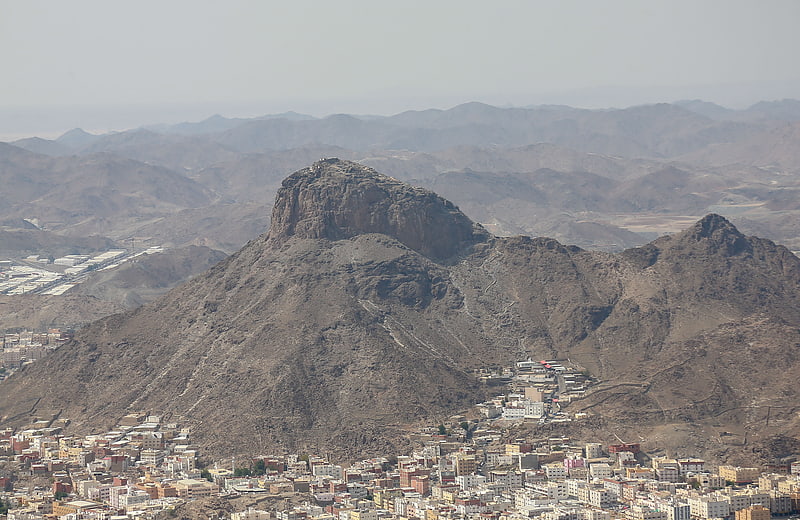
Also known as: جبل النور
Mountain for hiking to a famous cave. Jabal an-Nour is a mountain near Mecca in the Hejaz region of Saudi Arabia. The mountain houses the grotto or cave of Hira', which holds tremendous significance for Muslims throughout the world, as the Islamic prophet Muhammad is said to have spent time in this cave meditating, and it is widely believed that it was here that he received his first revelation, which consisted of the first five ayats of Surah Al-Alaq from the angel Jibra'il. It is one of the most popular tourist attractions in Makkah. The mountain itself is barely 640 m tall; nonetheless one to two hours are needed to make the strenuous hike to the cave. There are 1750 steps to the top which, even for a fit individual, can take anywhere between half an hour and one-and-a-half hours.[5]
Bay'ah Mosque
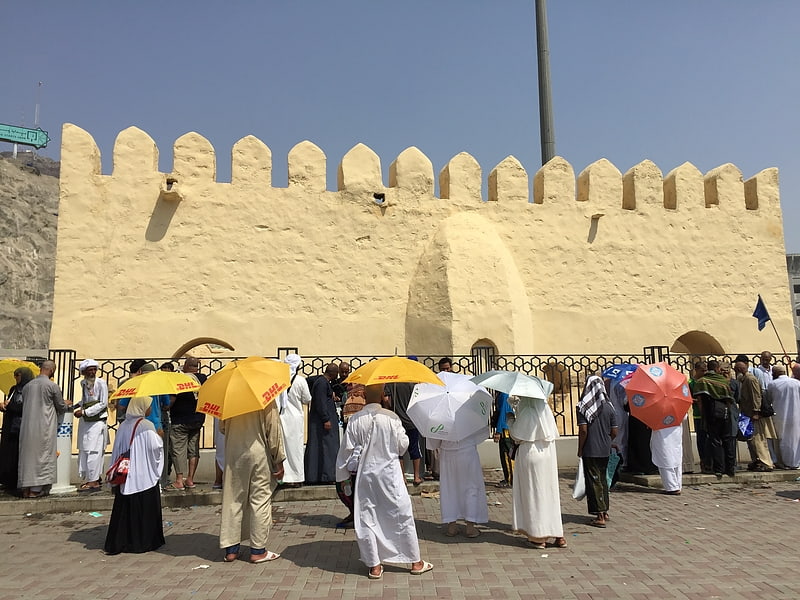
The Bay'ah Mosque, also known as the Mosque of 'Aqaba Hill, is a mosque outside Mecca in Saudi Arabia. It was built at the request of Caliph Abu Ja'far al-Mansur in 761/2 at the site of al-Bay'ah, i.e. the place where the Islamic Prophet Muhammad met with the Ansar, and they took the pledge of 'Aqaba.
The mosque has an open courtyard. It is located below the Wadi Mina, 300 meters from the jamrah al-'aqaba (see Stoning of the Devil), to the right of the bridge.[6]
Jannat al-Mu'alla
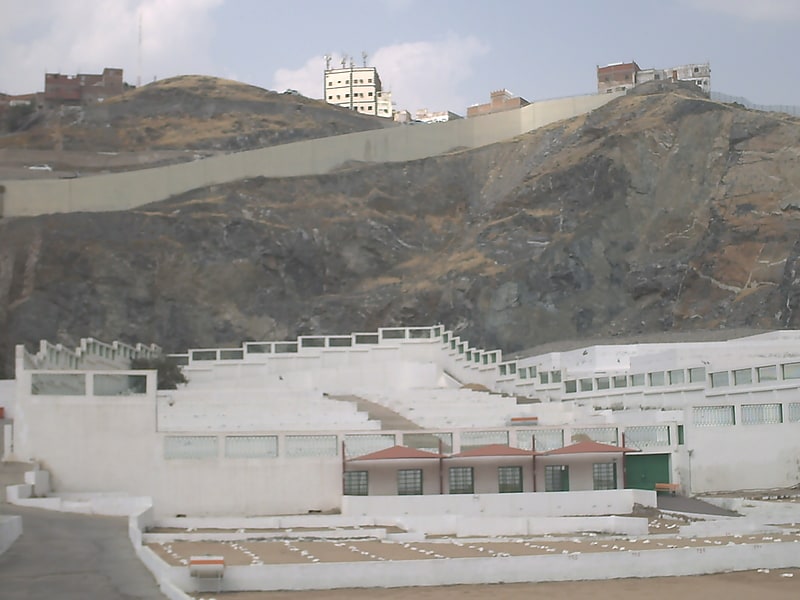
Also known as: مقبرة المعلاة
Cemetery in Mecca, Saudi Arabia. Jannat al-Mu'alla, also known as the "Cemetery of Ma'la" and Al-Ḥajūn, is a cemetery to the north of Al-Masjid Al-Haram, and near the Mosque of the Jinn in Makkah, Saudi Arabia. It is the place where the Islamic prophet Muhammad's wife, grandfather, and other ancestors are buried.[7]
Jamaraat Bridge

Also known as: جسر الجمرات
Pedestrian bridge in Mecca, Saudi Arabia. The Jamaraat Bridge is a pedestrian bridge in Mina, Saudi Arabia, near Makkah used by Muslims during the Hajj ritual Stoning of the Devil. The purpose of the bridge is to enable pilgrims to throw stones at the three jamrah pillars either from the ground level or from the bridge. Jamaraat is the plural of jamraah, the Arabic term for each of the pillars involved in the stoning ritual. It literally means a small piece of stone or a pebble.
The bridge was built in the 1963 and has been expanded several times since then. The pillars extend up through three openings in the bridge. Until 2006, the bridge had a single tier (i.e. a ground level with one bridge level above). At certain times, more than a million people may gather in the area of the bridge, which has sometimes led to fatal accidents.[8]
Stoning of the Devil
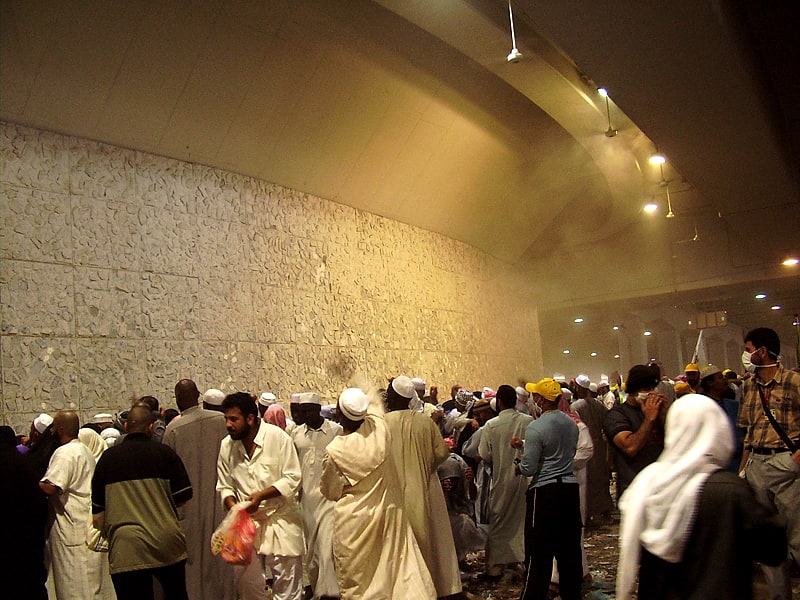
Also known as: جمرة العقبة
The Stoning of the Devil is part of the annual Islamic Hajj pilgrimage to the holy city of Mecca in Saudi Arabia. During the ritual, Muslim pilgrims throw pebbles at three walls, called jamarāt, in the city of Mina just east of Mecca. It is one of a series of ritual acts that must be performed in the Hajj. It is a symbolic reenactment of Ibrahim's hajj, where he stoned three pillars representing the temptation to disobey God.
On Eid al-Adha (the 10th day of the month of Dhu al-Hijjah), pilgrims must strike the Big Jamarah or Al-Jamrah Al-Aqaba with seven pebbles. After the stoning is completed on the day of Eid, every pilgrim must cut or shave their hair. On each of the following two days, they must hit all three walls with seven pebbles each, going in order from east to west. Thus at least 49 pebbles are needed for the ritual, more if some throws miss. Some pilgrims stay at Mina for an additional day, in which case they must again stone each wall seven times. The pebbles used in the stoning are traditionally gathered at Muzdalifah, a plain southeast of Mina, on the night before the first throwing, but can also be collected at Mina.[9]
Kaaba
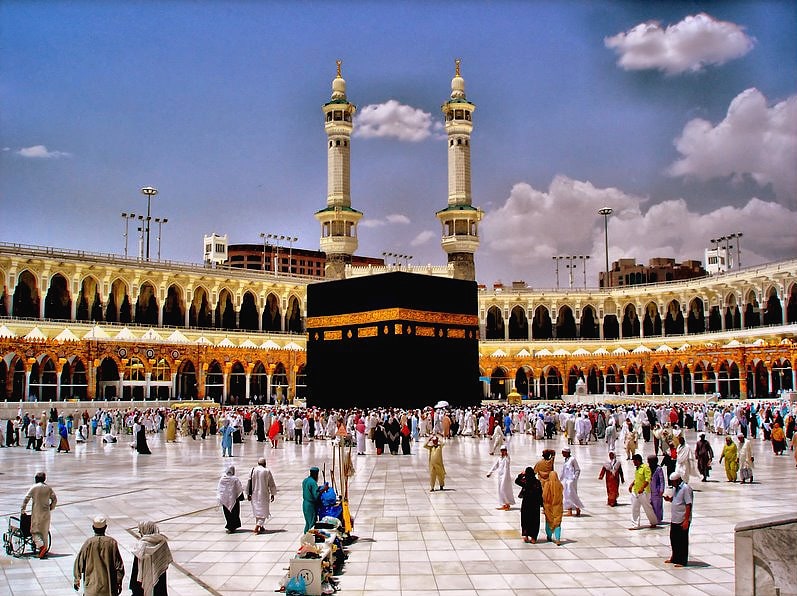
Also known as: الكعبة
Sacred mosque and Muslim pilgrimage site. The Kaaba, also spelled Ka'bah or Kabah, sometimes referred to as al-Kaʿbah al-Musharrafah, is a building at the center of Islam's most important mosque, the Masjid al-Haram in Mecca, Saudi Arabia. It is the most sacred site in Islam. It is considered by Muslims to be the Bayt Allah and is the qibla for Muslims around the world when performing salah.
In early Islam, Muslims faced in the general direction of Jerusalem as the qibla in their prayers before changing the direction to face the Kaaba, believed by Muslims to be a result of a Quranic verse revelation to Muhammad.
The Kaaba is believed by Muslims to have been rebuilt several times throughout history, most famously by Ibrahim (Abraham) and his son Ismail (Ishmael), when he returned to the valley of Mecca several years after leaving his wife Hajar (Hagar) and Ismail there upon Allah's command. Circling the Kaaba seven times counterclockwise, known as Tawaf (Arabic: طواف, romanized: tawaaf), is a Fard (obligatory) rite for the completion of the Hajj and Umrah pilgrimages. The area around the Kaaba where pilgrims walk is called the Mataaf.
The Kaaba and the Mataaf are surrounded by pilgrims every day of the Islamic year, except the 9th of Dhu al-Hijjah, known as the Day of Arafah, on which the cloth covering the structure, known as the Kiswah (Arabic: كسوة, romanized: Kiswah, lit. 'Cloth') is changed. However, the most significant increase in their numbers is during Ramadan and the Hajj, when millions of pilgrims gather for Tawaf. According to the Saudi Ministry of Hajj and Umrah, 6,791,100 pilgrims arrived for the Umrah pilgrimage in the Islamic year AH 1439 (2017/2018 CE), a 3.6% increase from the previous year, with 2,489,406 others arriving for the AH 1440 Hajj.[10]
Mina
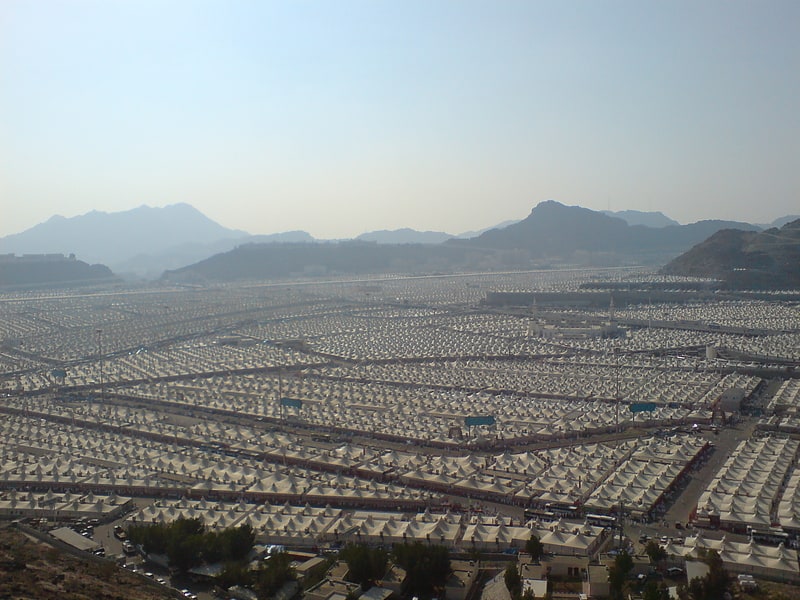
Also known as: منى
Neighborhood in Mecca, Saudi Arabia. Mina, also transliterated as Muna, and commonly known as the "City of Tents" is a valley and neighborhood located in the Masha'er district in the Makkah Province of Saudi Arabia, 8 kilometres southeast of the city of Mecca, covering an area of approximately 20 km2. Mina incorporates the tents, the Jamarat area, and the slaughterhouses just outside the tent city.
Mina is most famous for its role in the Hajj ("Pilgrimage"). To accommodate the pilgrims who stay in Mina over multiple nights in the month of Dhu al-Hijjah, more than 100,000 air-conditioned tents have been built in the area, giving Mina the nickname "City of Tents." With a capacity of up to 3 million people, Mina has been called the largest tent city in the world. The three Jamarat, located in the Mina valley, are the location of the Stoning of the Devil, performed between sunrise and sunset in the final days of the Hajj. The stone throwing ritual commemorates the Islamic Prophet Ibrahim (Abraham)'s stoning of the devil, who wanted to prevent him from carrying out the command of Allāh to sacrifice his son, Isma'il (Ishmael).[11]